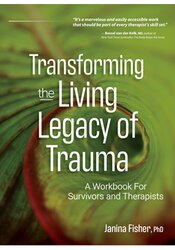How Post-Traumatic Symptoms Reflect Our Trauma History
When Our Nervous System Adapts to Threat in the Absence of Danger

The ingredients of post-traumatic stress disorder (PTSD) are found in the ways our nervous system still keeps trying to save our lives long after the danger is over. When we are triggered by some subtle cue connected to the past, we experience high sympathetic activation that communicates an alarm to the body and mind: ŌĆ£Red alert! Watch outŌĆödanger ahead!ŌĆØ An adrenaline response provides a surge of physical energy, strong instinctive impulses, and the icy calm that gives us a sense of superhuman power. But if action was dangerous then, the body may have also come to perceive sympathetic arousal as a threat, automatically triggering the parasympathetic system to slam on the brakes, bringing our movements to a grinding halt.
Years later, the parasympathetic system may still be dominant, robbing individuals of energy, drive, and confidence. Not knowing that their brains and bodies are causing these feelings and reactions, not knowing that traumatic events have conditioned their nervous systems to react in these ways, trauma survivors blame themselves and think, ŌĆ£IŌĆÖm depressedŌĆöeven though I have nothing to be depressed aboutŌĆØ or ŌĆ£IŌĆÖm just an angry personŌĆØ or ŌĆ£I donŌĆÖt know why IŌĆÖm afraid of everythingŌĆöIŌĆÖm just a chicken.ŌĆØ
But blaming ourselves is also triggering, and it can propel many individuals to try to fix these problems in ways that further worsen the situation. Even if we now live in a world that is rarely dangerous, we have a traumatized nervous system adapted to threat, and that adaptation keeps the living legacy of trauma mobilized in our bodies even when we do not need it anymore.

The figure shown here depicts the most common patterns of autonomic activation that develop as a response to chronic or repeated threat. As you look at the diagram, notice which patterns of arousal are most familiar to you. The pattern of nervous system responses to the environment and to ordinary stress that you notice in your life today tells the story of your survival, reflecting how your brain and body adapted to the traumatic conditions you once faced. Did you survive by being constantly on guard, tense, fearful, and reactive? Or did you survive by shutting down, going numb, and spacing out? Was it better for you to run or fight? Or was it better to collapse and go passive? Your body is actually telling you what was safest then, even if it is not helpful now. This diagram can also serve as a reminder to keep an eye on your nervous system so you can slow it down or speed it up as needed.
In addition, the following can help you become aware of how your sympathetic and parasympathetic nervous systems still react after the trauma has passed, how the nervous system still affects your feelings and behavior, and when you need to cultivate a wider window of tolerance.
Remember you had no control over how your nervous system responded at the time. The brain reacts long before we have conscious awareness of the situation, and we cannot control our instinctive reactions any more than a lizard can. Increasing awareness of these reactions as nervous system memories or survival responses often helps them to feel more tolerable. When we do not understand why we are going numb or jumping out of our skins, we feel more alarmed and ashamed of our reactions.
For more information on how to understand and increase awareness of these nervous system reactionsŌĆöand to heal from traumaŌĆö.
______
*This is an adapted excerpt from Transforming the Living Legacy of Trauma by Janina Fisher. Copyright ┬® 2021, Janina Fisher. ░┼└ų╩ėŲĄ Publishing & Media.
Years later, the parasympathetic system may still be dominant, robbing individuals of energy, drive, and confidence. Not knowing that their brains and bodies are causing these feelings and reactions, not knowing that traumatic events have conditioned their nervous systems to react in these ways, trauma survivors blame themselves and think, ŌĆ£IŌĆÖm depressedŌĆöeven though I have nothing to be depressed aboutŌĆØ or ŌĆ£IŌĆÖm just an angry personŌĆØ or ŌĆ£I donŌĆÖt know why IŌĆÖm afraid of everythingŌĆöIŌĆÖm just a chicken.ŌĆØ
But blaming ourselves is also triggering, and it can propel many individuals to try to fix these problems in ways that further worsen the situation. Even if we now live in a world that is rarely dangerous, we have a traumatized nervous system adapted to threat, and that adaptation keeps the living legacy of trauma mobilized in our bodies even when we do not need it anymore.

The figure shown here depicts the most common patterns of autonomic activation that develop as a response to chronic or repeated threat. As you look at the diagram, notice which patterns of arousal are most familiar to you. The pattern of nervous system responses to the environment and to ordinary stress that you notice in your life today tells the story of your survival, reflecting how your brain and body adapted to the traumatic conditions you once faced. Did you survive by being constantly on guard, tense, fearful, and reactive? Or did you survive by shutting down, going numb, and spacing out? Was it better for you to run or fight? Or was it better to collapse and go passive? Your body is actually telling you what was safest then, even if it is not helpful now. This diagram can also serve as a reminder to keep an eye on your nervous system so you can slow it down or speed it up as needed.
In addition, the following can help you become aware of how your sympathetic and parasympathetic nervous systems still react after the trauma has passed, how the nervous system still affects your feelings and behavior, and when you need to cultivate a wider window of tolerance.
Remember you had no control over how your nervous system responded at the time. The brain reacts long before we have conscious awareness of the situation, and we cannot control our instinctive reactions any more than a lizard can. Increasing awareness of these reactions as nervous system memories or survival responses often helps them to feel more tolerable. When we do not understand why we are going numb or jumping out of our skins, we feel more alarmed and ashamed of our reactions.
For more information on how to understand and increase awareness of these nervous system reactionsŌĆöand to heal from traumaŌĆö.
______
*This is an adapted excerpt from Transforming the Living Legacy of Trauma by Janina Fisher. Copyright ┬® 2021, Janina Fisher. ░┼└ų╩ėŲĄ Publishing & Media.
Transform traumatic experiences with this...

Dr. Janina Fisher, international expert on trauma, has spent over 40 years working with survivors, helping them to navigate the healing journey.
In Transforming the Living Legacy of Trauma, Janina shows how the legacy of symptoms helped them survive and offers:
Transforming the Living Legacy of Trauma is a workbook and guide to the journey to healing. As a ŌĆśguidebook,ŌĆÖ it describes the terrain to be explored, and it provides maps to help travelers find the best routes to a life beyond trauma.
In Transforming the Living Legacy of Trauma, Janina shows how the legacy of symptoms helped them survive and offers:
- Step-by-step strategies that can be used on their own or in collaboration with a therapist
- Simple diagrams that make sense of the confusing feelings and physical reactions survivors experience
- Worksheets to practice the skills that bring relief and ultimately healing
Transforming the Living Legacy of Trauma is a workbook and guide to the journey to healing. As a ŌĆśguidebook,ŌĆÖ it describes the terrain to be explored, and it provides maps to help travelers find the best routes to a life beyond trauma.
Meet the Expert:
Janina Fisher, Ph.D., is a licensed clinical psychologist and former instructor at The Trauma Center, a research and treatment center founded by Bessel van der Kolk. Known as an expert on the treatment of trauma, Dr. Fisher has also been treating individuals, couples and families since 1980.
She is past president of the New England Society for the Treatment of Trauma and Dissociation, an EMDR International Association Credit Provider, Assistant Educational Director of the Sensorimotor Psychotherapy Institute, and a former Instructor, Harvard Medical School. Dr. Fisher lectures and teaches nationally and internationally on topics related to the integration of the neurobiological research and newer trauma treatment paradigms into traditional therapeutic modalities.
She is co-author with Pat Ogden of Sensorimotor Psychotherapy: Interventions for Attachment and Trauma (2015) and author of Healing the Fragmented Selves of Trauma Survivors: Overcoming Internal Self-Alienation (2017) and the forthcoming book, Working with the Neurobiological Legacy of Trauma (in press).
Learn more about their educational products, including upcoming live seminars, by clicking here.
She is past president of the New England Society for the Treatment of Trauma and Dissociation, an EMDR International Association Credit Provider, Assistant Educational Director of the Sensorimotor Psychotherapy Institute, and a former Instructor, Harvard Medical School. Dr. Fisher lectures and teaches nationally and internationally on topics related to the integration of the neurobiological research and newer trauma treatment paradigms into traditional therapeutic modalities.
She is co-author with Pat Ogden of Sensorimotor Psychotherapy: Interventions for Attachment and Trauma (2015) and author of Healing the Fragmented Selves of Trauma Survivors: Overcoming Internal Self-Alienation (2017) and the forthcoming book, Working with the Neurobiological Legacy of Trauma (in press).
Learn more about their educational products, including upcoming live seminars, by clicking here.



